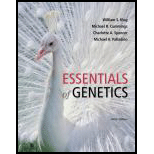
Concept explainers
Describe Mendel's conclusions about how traits are passed from generation to generation.
To review:
Mendel’s conclusion about the mechanism by which traits are passed from generation-to-generation.
Introduction:
Gregor Mendel was an Austrian monk who proved that traits are passed through a certain unit of heredity from one generation to another. He conducted experiments using pea plants with different variants. Before Mendel, people had a concept that the traits were inherited by the next generation due to the blending of parental characters just like colors.
Explanation of Solution
Mendel conducted experiments using pea plants with variants such as variation in flower color, pod color and shape, seed color, and many other characters. That was a long series of experiments. Mendel got various results, which indicated that traits are transferred from one generation to another in a specific way that can be predicted.
He concluded that there are certain factors responsible for passing traits to offspring from the parents. These factors control the traits. This means each trait is controlled by a pair of a factor. These factors were later known as genes. At the time of gamete formation, the gene pair gets separated from each other. For a single trait, the offspring get one gene from each parent and have the pairing of two genes. Thus, the traits are transferred through genes.
Therefore, it can be concluded that according to Mendel, traits from the parents to offspring are transmitted through predictable factors known as genes.
Want to see more full solutions like this?
Chapter 1 Solutions
Essentials of Genetics (9th Edition) - Standalone book
- Noggin mutation: The mouse, one of the phenotypic consequences of Noggin mutationis mispatterning of the spinal cord, in the posterior region of the mouse embryo, suchthat in the hindlimb region the more ventral fates are lost, and the dorsal Pax3 domain isexpanded. (this experiment is not in the lectures).a. Hypothesis for why: What would be your hypothesis for why the ventral fatesare lost and dorsal fates expanded? Include in your answer the words notochord,BMP, SHH and either (or both of) surface ectoderm or lateral plate mesodermarrow_forwardNot part of a graded assignment, from a past midtermarrow_forwardNot part of a graded assignment, from a past midtermarrow_forward
- please helparrow_forwardWhat does the heavy dark line along collecting duct tell us about water reabsorption in this individual at this time? What does the heavy dark line along collecting duct tell us about ADH secretion in this individual at this time?arrow_forwardBiology grade 10 study guidearrow_forward
 Human Biology (MindTap Course List)BiologyISBN:9781305112100Author:Cecie Starr, Beverly McMillanPublisher:Cengage Learning
Human Biology (MindTap Course List)BiologyISBN:9781305112100Author:Cecie Starr, Beverly McMillanPublisher:Cengage Learning Biology Today and Tomorrow without Physiology (Mi...BiologyISBN:9781305117396Author:Cecie Starr, Christine Evers, Lisa StarrPublisher:Cengage Learning
Biology Today and Tomorrow without Physiology (Mi...BiologyISBN:9781305117396Author:Cecie Starr, Christine Evers, Lisa StarrPublisher:Cengage Learning Human Heredity: Principles and Issues (MindTap Co...BiologyISBN:9781305251052Author:Michael CummingsPublisher:Cengage Learning
Human Heredity: Principles and Issues (MindTap Co...BiologyISBN:9781305251052Author:Michael CummingsPublisher:Cengage Learning Concepts of BiologyBiologyISBN:9781938168116Author:Samantha Fowler, Rebecca Roush, James WisePublisher:OpenStax College
Concepts of BiologyBiologyISBN:9781938168116Author:Samantha Fowler, Rebecca Roush, James WisePublisher:OpenStax College Biology 2eBiologyISBN:9781947172517Author:Matthew Douglas, Jung Choi, Mary Ann ClarkPublisher:OpenStax
Biology 2eBiologyISBN:9781947172517Author:Matthew Douglas, Jung Choi, Mary Ann ClarkPublisher:OpenStax Biology (MindTap Course List)BiologyISBN:9781337392938Author:Eldra Solomon, Charles Martin, Diana W. Martin, Linda R. BergPublisher:Cengage Learning
Biology (MindTap Course List)BiologyISBN:9781337392938Author:Eldra Solomon, Charles Martin, Diana W. Martin, Linda R. BergPublisher:Cengage Learning





